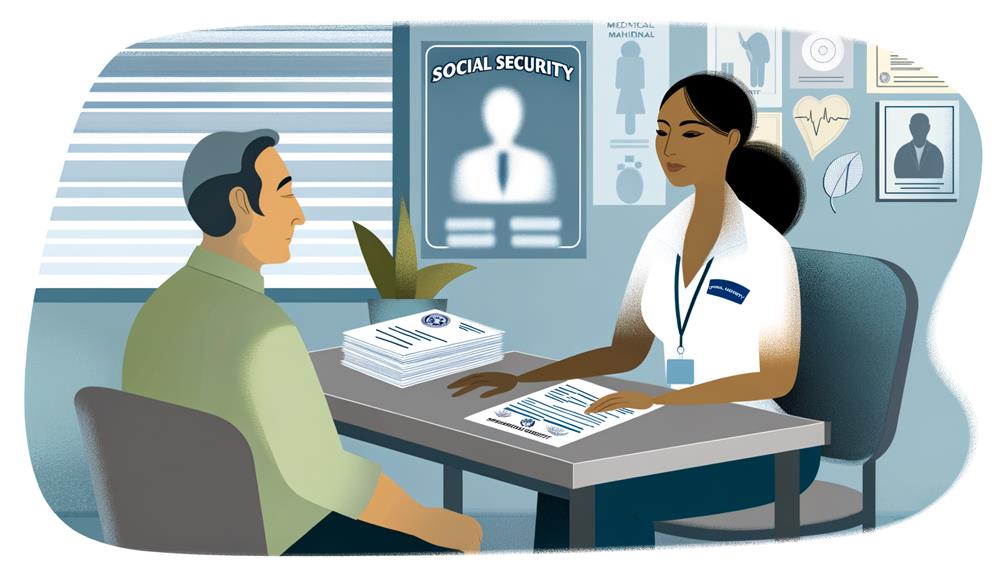You might be wondering if schizoaffective disorder qualifies as a disability. It's a complex question that hinges on how greatly the disorder impacts your daily life and work capabilities. The Social Security Administration has specific criteria for determining eligibility, but it's not as straightforward as you might think. Does experiencing severe symptoms like hallucinations or mood disturbances over an extended period automatically make you eligible? And what kind of documentation is required to prove your case? There's more to the process than meets the eye, and understanding each step could be essential for those affected.
Contents
Understanding Schizoaffective Disorder
Understanding schizoaffective disorder involves recognizing the complexity of its symptoms and the significant impact it has on individuals' lives. This mental health condition is defined by a combination of schizophrenia symptoms, such as hallucinations and delusions, and mood disorder symptoms, which can include depressive episodes and periods of mania. The dual nature of schizoaffective disorder makes it particularly challenging to diagnose and treat effectively.
Approximately 58 million people are affected annually by schizoaffective disorder, underscoring its prevalence and the substantial burden it places on public health systems. For those living with this condition, the symptoms can lead to severe impairments in daily functioning, making it difficult to maintain employment and manage personal relationships. These functional impairments often qualify schizoaffective disorder as a disability, given the considerable limitations it imposes on various aspects of life.
Diagnosis of schizoaffective disorder requires an extensive clinical evaluation by a mental health professional. There are no definitive lab tests for this condition, which means that the assessment relies heavily on detailed patient history and symptomatology. Clinicians must carefully differentiate between schizoaffective disorder and other mental health conditions, such as schizophrenia or bipolar disorder, to guarantee accurate diagnosis and appropriate treatment.
Effective treatment strategies for schizoaffective disorder typically involve a combination of medication and psychotherapy. Antipsychotics and mood stabilizers are commonly prescribed to manage the psychotic and mood-related symptoms, respectively. Psychotherapy plays an essential role in helping individuals cope with their symptoms, improve their quality of life, and develop strategies for managing daily challenges. This multifaceted approach reflects the complexity of schizoaffective disorder and the need for tailored, evidence-based interventions to address its diverse manifestations.
Daily Life Impact

How does schizoaffective disorder impact daily life? Schizoaffective disorder markedly impairs daily functioning, making routine tasks and relationship maintenance challenging. Individuals often experience mood swings and cognitive dysfunction, which directly affect their ability to perform everyday activities. Emotional regulation challenges commonly lead to isolation, as you might struggle to connect with others or participate in social activities. This isolation can exacerbate mental health issues, creating a vicious cycle that further impairs your daily functioning.
In the workplace, schizoaffective disorder can severely hinder work capacity. Concentration and memory difficulties are frequent, impacting your job performance and employment stability. You might find it hard to focus on tasks, remember important details, or follow through with responsibilities, making it challenging to maintain a steady job. This instability in employment can contribute to financial stress, which in turn, may worsen mental health symptoms.
Mood episodes, which can vary in intensity and duration, are another notable factor disrupting daily routines. These episodes can make it difficult to adhere to a structured schedule, affecting everything from personal hygiene to household chores. The unpredictability of mood swings further complicates planning and consistency in daily activities.
Early diagnosis and treatment are essential. Timely intervention can improve your overall quality of life and reduce the severity of symptoms that disrupt daily activities. Effective management of the disorder can help you better navigate the complexities of daily functioning, potentially making it easier to manage routines and social interactions.
In essence, the impact of schizoaffective disorder on daily life is profound, affecting your mental health and functional capabilities, which is a vital consideration when evaluating disability claims.
Disability Eligibility Criteria

To determine if schizoaffective disorder qualifies as a disability, you'll need to meet the Social Security Administration's criteria under Section 12.03 or 12.04. This involves showing severe functional limitations from symptoms like hallucinations or mood disturbances that greatly affect daily activities. Extensive medical documentation proving the persistence and severity of your condition is essential for substantiating your claim.
SSA Eligibility Criteria
For individuals seeking Social Security Disability (SSD) benefits due to schizoaffective disorder, meeting the SSA eligibility criteria is vital. Your Social Security disability application must clearly demonstrate severe functional limitations caused by schizoaffective symptoms, supported by robust medical evidence.
To qualify under SSA guidelines, you need to:
- Document Symptoms: Provide evidence of psychotic symptoms or mood episodes. The SSA evaluates claims under Section 12.03 (Schizophrenia) or Section 12.04 (Affective Disorders).
- Prove Duration: Show that your condition has lasted or is expected to last for at least one year, affecting your ability to perform substantial gainful activity (SGA).
- Medical Records: Confirm your application includes thorough medical evaluations and treatment history to substantiate your claims.
- Sequential Evaluation: Undergo SSA's five-step sequential evaluation process, which assesses non-work activity, symptom severity, medical listing criteria, past work capability, and any other work potential based on residual functional capacity (RFC).
Meeting these criteria provides a structured approach to proving the severity of your condition. Each piece of medical evidence is vital in showing how schizoaffective disorder impacts your daily life and work capabilities, making a compelling case for your SSD benefits.
Functional Limitations Impact
Functional limitations play a significant role in determining disability eligibility for individuals with schizoaffective disorder. This mental health condition can lead to substantial impairments in cognitive abilities, emotional regulation, and social relationships. These functional limitations are essential in disability evaluations. To qualify for disability benefits, the Social Security Administration (SSA) requires extensive documentation demonstrating how these limitations affect daily activities.
You'll need to show severe limitations in areas such as concentration, persistence, and social interaction. According to SSA guidelines under Sections 12.03 and 12.04, evidence of ongoing symptoms that prevent you from performing work-related tasks for at least 12 months is vital.
Providing a thorough treatment history and medical records that outline the extent of your functional impairments is significant. The SSA looks for detailed information on the severity and frequency of mood episodes and psychotic symptoms to illustrate their negative impact on your ability to engage in substantial gainful activity.
SSA Evaluation Process

When determining if schizoaffective disorder qualifies as a disability, the SSA uses a structured 5-step evaluation process. You'll need thorough medical documentation to demonstrate how the disorder considerably limits your ability to work, aligning with the SSA's criteria at each step. This process involves examining your earnings, medical severity, listing criteria, past relevant work, and potential for other work based on your residual functional capacity.
Five-Step Disability Determination
The Social Security Administration (SSA) employs an extensive five-step process to determine disability eligibility, guaranteeing that only those who genuinely meet the criteria receive benefits. This process meticulously examines each claimant's medical condition and work capabilities to ascertain their qualification for disability benefits.
- Substantial Gainful Activity (SGA): The first step verifies that you aren't engaged in SGA, with a current earning threshold of $1,090 per month. If your earnings exceed this limit, you're typically not considered disabled.
- Severity of Medical Condition: Step two requires substantial medical evidence showing that your condition greatly limits basic work activities. This is vital in establishing the severity of your disability.
- Medical Listings: In the third step, the SSA checks if your condition meets or equals the criteria in the SSA's medical listings, specifically under Section 12.03 for schizophrenia or Section 12.04 for affective disorders. Meeting these listings can expedite the approval process.
- Residual Functional Capacity (RFC): Steps four and five assess your ability to perform past relevant work and consider if you can adjust to other work. This involves evaluating your RFC and skills, determining if any employment is feasible given your limitations.
This structured approach guarantees a thorough assessment of your eligibility for disability benefits.
Importance of Medical Documentation
In order to substantiate claims of schizoaffective disorder, thorough medical documentation is absolutely essential, providing objective evidence of the condition's severity and impact on daily functioning. The Social Security Administration (SSA) requires detailed records from qualified healthcare providers to assess your disability claim. These records should include treatment history, mental status examinations, and any hospitalization documentation. Without this extensive medical documentation, proving the severity of your mental health condition can be remarkably challenging.
It's important to demonstrate that your symptoms greatly limit basic work activities. This is done through Activities of Daily Living (ADLs) and Vocational Questionnaires, which are integral components of the medical evidence required by the SSA. Consulting specialized professionals, such as psychiatrists or psychologists, can enhance the credibility of your claim. Their expert evaluations and documentation are aligned with the SSA's listing criteria for mental disorders, making your case stronger.
Meeting Section 12.03 Criteria

To qualify for Social Security Disability (SSD) benefits under Section 12.03 for schizoaffective disorder, you must meet specific diagnostic and functional criteria. This involves demonstrating the presence of psychotic symptoms, such as hallucinations or delusions, that persist for at least two years. The documentation from a qualified mental health professional is vital in establishing these symptoms and their impact on your daily functioning.
Here's what you need to focus on:
- Psychotic Symptoms: You need to exhibit at least one psychotic symptom like hallucinations or delusions. These symptoms must be documented by a mental health professional.
- Functional Limitations: Show how these symptoms impede basic work activities. This includes significant limitations in social interactions and daily tasks.
- Duration: The psychotic symptoms and functional limitations must persist for at least two years. This means consistent medical documentation over this period is essential.
- Severity: The severity of your symptoms should be clearly documented in your medical records. This includes treatment history, any hospitalizations, and the overall impact on your ability to function.
Meeting the Section 12.03 criteria is essential for establishing the link between schizoaffective disorder and functional impairments needed to qualify for SSD benefits. The documentation from a qualified mental health professional can make or break your disability claim. Medical records should detail the presence of psychotic symptoms and their impact on daily life. The evidence must show that these symptoms are severe enough to prevent you from performing basic work activities, thereby justifying the need for disability benefits.
Meeting Section 12.04 Criteria

Qualifying for Social Security Disability (SSD) benefits under Section 12.04 requires you to demonstrate that your schizoaffective disorder includes recurrent episodes of depression or prolonged mania, greatly impacting your daily functioning. To meet the requirements, your symptoms must encompass at least four specific criteria: appetite changes, sleep disturbances, fatigue, difficulty concentrating, and feelings of worthlessness or guilt.
Meeting the Section 12.04 criteria involves showcasing that these symptoms are not only present but persistent, requiring thorough documentation over an extended period. Your medical records should reflect consistent evaluations from qualified healthcare providers, detailing the severity and frequency of your mood episodes. This evidence is vital for establishing a clear connection between your condition and the significant limitations it imposes on your daily life.
The severity of your mood episodes must result in considerable limitations in various areas, such as social interactions or work capacity. For instance, you might find it challenging to maintain relationships or perform job-related tasks consistently. The Social Security Administration (SSA) looks for evidence that your condition substantially restricts your ability to function in these domains.
It's important to note that simply having a diagnosis of schizoaffective disorder isn't enough to qualify for disability benefits. You must meticulously demonstrate how your severe mood episodes directly interfere with your daily functioning. By meeting these stringent criteria, you stand a better chance of being recognized as eligible for SSD benefits under Section 12.04.
Seeking Professional Support

Seeking professional support is a fundamental step in managing schizoaffective disorder, especially when aiming to qualify for disability benefits. Accurate diagnosis and effective treatment management necessitate the involvement of a psychiatrist, who can provide essential medical records. These records document your evaluations and treatment history, which are critical in substantiating your disability claim and demonstrating how the disorder impacts your daily functioning.
To enhance your chances of claim approval, consider the following steps:
- Engage a Psychiatrist: This specialist will offer precise diagnoses and ongoing treatment plans, which are crucial for thorough medical records.
- Maintain Detailed Records: Consistently update and preserve all medical evaluations, treatment changes, and progress notes to support your claim.
- Consult a Disability Attorney: An attorney can guide you through the complex paperwork and guarantee that compelling medical evidence is presented accurately.
- Regular Follow-ups: Continued interactions with healthcare providers help monitor symptoms and adjust treatment plans, strengthening the credibility of your claims.
Involving a disability attorney can be particularly advantageous. They bring expertise in maneuvering the legal intricacies of disability applications, from guaranteeing all paperwork is correctly filled out to presenting a compelling case with robust medical evidence. This professional guidance can substantially increase the likelihood of your claim being approved.
Moreover, don't underestimate the value of support networks. Family and community resources can provide emotional support and practical assistance throughout the application process. Consistent follow-ups with healthcare providers further demonstrate your commitment to managing the disorder, which can reinforce the legitimacy of your disability claim.
Conclusion
In summary, if you have schizoaffective disorder and it greatly impairs your daily functioning and work capabilities, you might be eligible for disability benefits under SSA criteria. You'll need thorough medical documentation showing severe, persistent symptoms that limit basic activities and social interactions. Meeting the criteria outlined in Sections 12.03 and 12.04 is essential. Professional support can enhance the accuracy and completeness of your application, increasing your chances of obtaining the necessary benefits.
